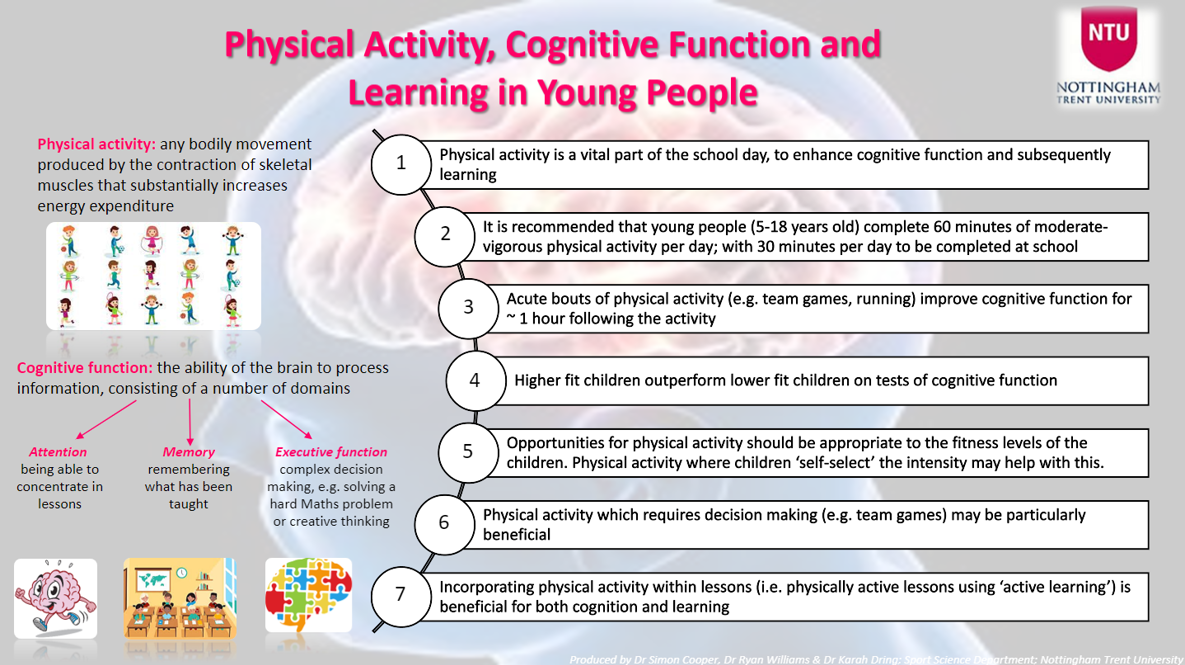1. Physical activity is a vital part of the school day to enhance cognitive function and subsequently learning
We passionately believe that physical activity is a vital part of the school day and that all young people should have the opportunity to be active daily. In this blog to accompany the infographic, we break down some of the scientific evidence in this area and explain how we can use the power of physical activity to enhance cognitive function and subsequently learning in young people. Links to the underpinning scientific evidence and papers are also provided for those who want to read the original research.
2. It is recommended that young people (5-18 years-old) complete 60 minutes of moderate-vigorous physical activity per day, with 30 minutes per day to be competed at school
Young people aged 5-18 years-old are recommended to complete 60 minutes every day of at least moderate intensity physical activity (Chief Medical Officer, 2019). This includes all forms of activity, such as play, walking, running, swimming, active travel, cycling, sport and PE. It is also recommended that young people should engage in a variety of types and intensities of physical activity across the week to develop movement skills, muscular fitness, and bone strength. Young people should also aim to minimise the amount of time spent being sedentary (i.e. sitting), and should break up long periods of sedentary time with at least light physical activity (i.e standing and walking activities). The full Chief Medical Officers Physical Activity guidelines can be found here, and a useful infographic summarising the guidelines here.
3. Acute bouts of physical activity (e.g. team games, running) improve cognitive function for one hour following the activity
A substantial body of evidence demonstrates that when a young person completes some physical activity, their cognitive function is improved for approximately one hour following the activity (Donnelly et al., 2016; Williams, Hatch & Cooper, 2019). Specifically, we have shown that cognitive function (across the important domains of attention, memory and executive function) is enhanced following moderate intensity running, high intensity intermittent sprinting, and team games such as basketball in adolescent boys and girls. These effects last for approximately one hour, which highlights the importance of regular opportunities for physical activity to be included within the school day.
4. High fit children outperform low fit children on tests of cognitive function
Another consistent finding from the literature is that young people who have greater cardiorespiratory fitness display superior cognition when compared to children who have lower fitness. We have demonstrated this in both primary and secondary school children (primary school: Hatch et al., 2021; secondary school: Cooper et al., 2018; Williams et al., 2020). This is a really important finding because it suggests that opportunities for young people to regularly complete physical activity (which we know will increase fitness) are really important and should be provided to all young people.
5. Opportunities for physical activity should be appropriate to the fitness levels of the children. Physical activity where children ‘self-select’ the intensity may help with this
There is an emerging body of evidence to suggest that it is important that the opportunities for physical activity provided to young people should be appropriate to their fitness levels to maximise cognitive benefits. Once again, we have shown this in both primary (Hatch et al., 2021) and secondary school (Cooper et al., 2018) pupils. Physical activity where children can self-select the intensity which they exercise at allows children to achieve this; for example, The Daily Mile in primary schools is a great example of an activity that allows children to achieve improvements in cognition.
6. Physical activity which requires decision making (e.g. team games) may be particularly beneficial
There is also emerging evidence that physical activity which requires some form of decision making (i.e. cognitive engagement) may be particularly beneficial for subsequent cognitive function. For example, playing both basketball and football, as well as a circuit of exercises that were designed to be cognitively engaging, have been shown to have positive effects on cognitive function in young people. It is also really important to consider that young people are far more likely to regularly complete physical activity if they enjoy it; thus, the use of team games could be particularly effective.
7. Incorporating physical activity within lessons (i.e. physically active lessons using ‘active learning’) is beneficial for both cognition and learning
Many schools implement active learning – whereby they incorporate the use of physical activity into their academic lessons to enhance learning. A number of reviews suggest that this approach is beneficial for cognitive performance and academic achievement (e.g. Watson et al., 2017; Daly-Smith et al., 2018; Singh et al., 2019). This may be a particularly attractive option for schools who are concerned about incorporating physical activity within the curriculum at the expense of the time spent on other ‘academic’ subjects.

